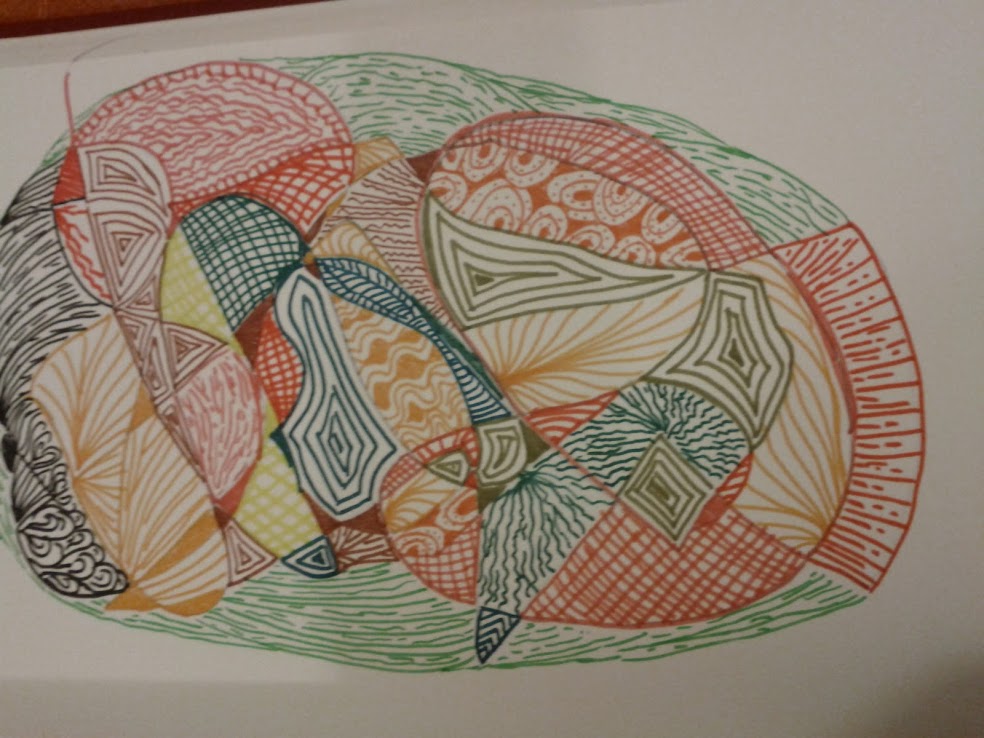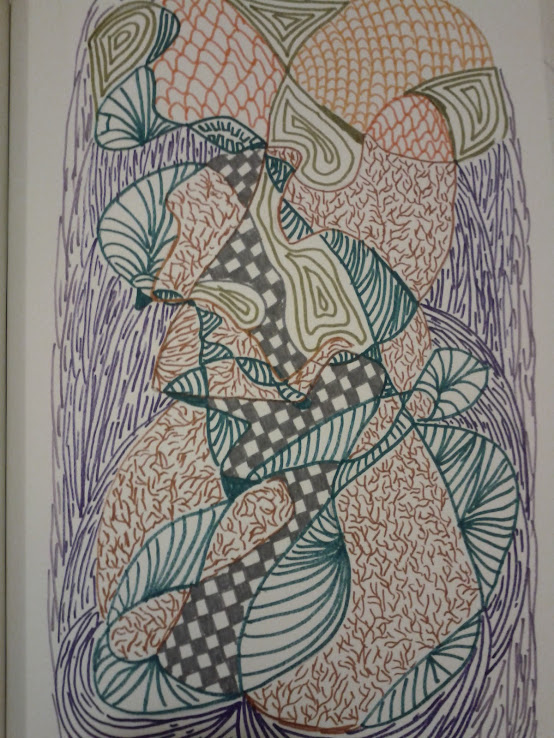Exercise 4 - Scribble art

In this exercise we attempt to reconnect with the child we used to be, by 'scribbling'. In doing so, we leave behind the inhibitory overlay of adult thinking and reconnect with the symbols and images that inhabit our unconscious. These symbols and images connect us to the archetypes which influence our lives. Archetypes, were described by Carl G. Jung as "ancient or archaic images that derive from the collective unconscious." He defined the collective unconscious as containing al the knowledge and experiences which we share as a species.
Children, take great pleasure in making marks. If left to their own devices, as early as one-and-a-half year, a child will pick up a crayon, pencil, pen, lipstick or whatever happens to be at hand and scribble - often on the walls. Until recently, it was thought that the pure joy of moving their arms and making a mark was the sole motivation for this. Now, some researchers believe that the child is actually experimenting with representation, even though the scribbles may not contain recognisable forms. This new perspective suggests that children’s scribbles may be more complex than previously thought.a
As a child grows, his/her capacity to create representational drawings increases, unfortunately so too does the capacity to judge and criticise one's own art work. We move away from valuing our art-making activities merely for the pure joy the process allows us, to valuing or devaluing it based on our judgement of the end product.

The closer the child approaches adolescence, the more he loses the strong subjective relationship to the world of symbols.
- Viktor Lowenfeld
There is a way to counteract this development and it is best summed up by Clarissa Pinkola Estes, a Jungian analyst and cantadora (story-teller). She wrote:
"In my family there's a saying that is good for those of us who are sensitive... It is, if you listen deeply enough, you will always hear the negative. Sometimes we have to allow people around us not to catch our analytic spirit and just bless down hard on them and then walk on."
Basically the scribble is used as a visual starter, but for the process to be meaningful it is necessary to relax. I started by using a method devised by Cathy A. Malchiodi, but then went on to 'engage' with my image in the different ways set out below:

Materials you will need
1. A paper 18 x 24 inches in dimension
2. Crayons, textas, chalks, pastels. I prefer felt-tipped pens
3. A notebook - suggested size A4 or smaller (to carry about with you and use on a daily basis when inspiration strikes)
Steps:
(Ensure that you will be undisturbed for at least 45 minutes when attempting this exercise. Please read all the steps before you begin.)
1. Choose a spot in which to meditate. Make sure that your art supplies and notebook are laid out in front of you ready for use. Sit in a straight-backed chair. If you wish, you could use candles, aromatherapy or music to relax yourself.
2. In your notebook, write down:
(a) Three words which describe how you are feeling (before beginning the exercise).
(b) Three sentences on why you are doing the exercise.
3. With your feet firmly on the ground and your eyes closed, take a few deep slow breaths. When you feel completely centred and relaxed, open your eyes.
4. Set out your art materials before you. Tape the paper you are suing to a board or table so that it won't move. Ensure that your pens/pencils/pastels etc are close to your dominant hand.
5. Close your eyes. Pick up whichever drawing tools comes to hand and scribble for 30 seconds or until you are ready to open your eyes. Don't think while you are doing the exercise, just do it.
6. When you have finished, open your eyes, take a good look at your 'scribble' and try to discern an image within it. To do this, you will have to look at your picture from all sides, may be hang it on a wall and step back to gain a complete perspective. After you find the 'image', colour it in, add details and lines if need be to bring it into "clearer focus".
7. Hang it up, think of a title.
8. Notice any thoughts, words, feelings or snatches of music which come to mind when you look at it. Note them down in your notebook.
9. Imagine you are the image. If that were the case, what would you say? How do you feel? Are you happy to be 'scribbled up' or do you wish to 'hide'? Are you friendly? Angry? Shy? Write a short story about your image. It could be as short as a paragraph or as long as you wish.
10. When you have finished 'being' the image, think through your own feelings, thoughts and ideas about the process you just went through. Note them down in your notebook and paste your scribble art alongside these notes. Date the work.
11. You may do as many pieces of scribble art as you wish. When you have a 'collection' have a look at them and the accompanying notes. Is there a pattern or theme?
12. If the exercise grabs your fancy, maintain a scribble art book and note if specific ideas/images/feelings recur.
The purpose of this exercise is to make initial contact with the archetypes which 'govern' one's life. For each person, these are different. The following are a few of the archetypes described by Jung. Did any of them feature in your images?
- The father: Authority figure; stern; powerful.
- The mother: Nurturing; comforting.
- The child: Longing for innocence; rebirth; salvation.
- The wise old man: Guidance; knowledge; wisdom.
- The hero: Champion; defender; rescuer.
- The maiden: Innocence; desire; purity.
- The trickster: Deceiver; liar; trouble-maker.
References
Books
1. Art Therapy Sourcebook,2nd Edn. (2006) Machiodi, C, McGraw-Hill
2. Introduction to Art Therapy: Sources and Resources, (2009), Rubin, J.A., CRC Press
3. Little Windows into Art Therapy: Small Openings for Beginning Therapists (2005) Schroder, Deborah, Jessica Kingsley Publications
4. Introduction to Art Therapy, (2008) Moon, Bruce, L., Charles C. Thomas Publisher
5. Liber novus (The Red Book), (2009) Jung, C.J., translated by Sonu Shamdasani, W.W. Norton & Co.
6. The Structure and Dynamics of the Psyche (Collected Works of C.G. Jung, Volume 8) 2nd Edn, Jung, C.G. (1970) , Princeton University Press
URLs
a. 'Young in Art - a developmental look at child art' (1990) Roland, Craig, www.artjunction.org
b. http://psychcentral.com/blog/archives/2011/08/06/art-therapy-exercises-to-try-at-home/
c. http://arttherapyreflections.blogspot.com.au/2009/03/art-therapy-exercises-scribble-drawings.html


I am going to use this with my Healing with Art class on Thursday to teach the different models of therapeutic art. Thank you so much for posting it.
ReplyDelete